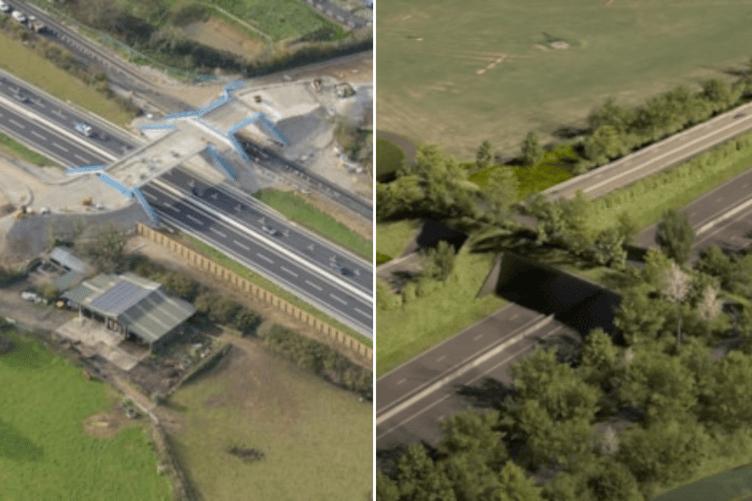National Highways is busy preparing its third green bridge – a second for Cornwall – over the coming weeks.
As part of the major A30 Chiverton to Carland Cross dualling project, a dual-deck bridge has been constructed by contractors Costain over the new carriageway, with top soiling work now under way, turning the bridge from grey to brown, followed by ‘green’ planting in the autumn
Following the topsoiling and planting, the green bridge at Marazanvose will cater for a different type of traffic, providing a flourishing green border and a safe passage across the road for various wildlife species, including badgers, voles and other small animals, insects and birds.
The bridge – 49.3 metres in length and 12.5 metres wide – spans four lanes of the new dual carriageway and two lanes of the old A30, now the B3288, and will not only provide better connectivity for wildlife but also a footpath and a bridleway for horse riders.
Landscaping will involve the planting of two native hedgerows, with species including Hazel, Hawthorn, Holly, Dog Rose, Elder and Wych Elm, along with Hazel and Hawthorn trees and seeding of grasses and wildflowers.
Green bridges are now becoming an important part of the sustainability of infrastructure projects, by: creating a safe crossing point for wildlife movement; joining up habitats and connecting colonies, and making wildlife populations more resilient.
There are only a handful of green bridges across the country and for National Highways, it represents the third such structure to be built across the Strategic Road Network, and a second for Cornwall following Cormac’s construction of the A391 Carluddon road bridge.
Andrew Alcorn, National Highways’ programme manager for the A30 Chiverton to Carland Cross scheme, said: “We’re really proud of the environmental work being carried out as part of this project, and the creation of the green bridge is a leading part of that.
“Our green bridge will be the third for the company, one of only a handful across the country, and once completed, it will provide a safe crossing for various species of wildlife, as well as for walkers and horse riders.
“Along with other environmental measures, we’ve built a total of 33 multi-species crossing points as part of the project, and we look forward to seeing the bridge bloom for many years to come, providing a real legacy for the scheme and for Cornwall.”
Planting work will take place in the autumn, along with seeding, and after all planting work across the scheme, a five-year maintenance period will follow to ensure the successful bedding in and growth of all new trees and shrubs.
The new route has been designed to enhance biodiversity and improve connectivity for wildlife, with a total of 33 multi-species crossing points constructed alongside the new junction structures, to enable the journeys of animals such as otters, badgers, bats and reptiles, allowing access to a wider area of habitat.
As part of the environmental mitigation work, National Highways and principal contractors Costain are predicting an approximate 20 per cent net gain in biodiversity.





Comments
This article has no comments yet. Be the first to leave a comment.